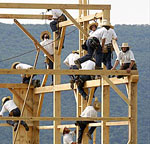The Amish movement was started in 1693 by Jacob Amman, an Anabaptist (Mennonite) church leader in the Rhine Valley of Switzerland, who felt that the Mennonite church was not keeping in strict separation from the world and that spiritual renewal was needed. Ammann did not believe that the ban, or shunning, was being practiced as it should be. He separated from the Anabaptists (Mennonites) over the issue of shunning, and his followers were nicknamed Amish.

Today, the Amish are a very conservative Christian faith group. They keep themselves separate from the rest of the world, both physically and socially. Some of the ways the Amish separate themselves from society include: married men wear untrimmed beards (but no moustache); using horse and buggy for transportation and farming; wearing plain and distinctive dress patterns and prayer veilings; using gas and propane for power; and using hooks and eyes, or straight pins in place of buttons.
Amish homes do not draw power from the electrical grid, because that would connect them to the world and its hurried ways. The majority of Amish are Old Order, which means they do not own cars and if they have a phone, it is in a booth in the front yard (to discourage idle chatter and use of technology). When not driving around in horse and buggy, the younger Amish can be seen on push scooters. On Mondays, the traditional wash day in Old Order communities, you can see clotheslines full of beautiful Amish Quilts in the breeze.
The Amish believe they must never resort to violence or participate in war, but do not view themselves as pacifists, because that would require them to be politically active (which would go against their belief of separation from the world and its government). They do not vote, and also do not pay social security tax (because they take care of their own elderly parents, often providing a Dawdy house for them to live in attached to their own home).
Quilting Bees are common in the Amish communities, and are a way for the women of the local district to get together and fellowship while getting something useful accomplished. The Amish quilter often will donate at least one of her Amish quilts to benefit the local Amish school
The older women wear darker solid colored below-the-knee length dresses with their modesty cape and apron in black, and the younger girls wear solid pastel colored dresses of the same style. The head coverings are distinctive to each region, but are generally made of a white linen or a white organdy mesh fabric, and covered with a black bonnet during winter. The men wear long black pants, without buttons (using hook and eye), and solid colored pastel collared shirts and suspenders. They wear either straw hats in summer, or black felt broad-rimmed hats in winter. Children are numerous, and family gatherings frequent. School is taught by a young Amish single woman, and their one-room schoolhouse is home to grades 1 - 8 (with boys and girls outhouses in the backyard).
A young Amish girl will learn to piece quilts on the treadle sewing machine around age 10, and by the time she reaches her teen years, she will have already helped in quilting numerous quilts for the home and for friends. Amish Quilts are an important part of the community life the Amish lead, and the Amish quilter is welcomed in Quilting bees which are held throughout the year.
Our Amish Quilter has been quilting, on an average, over 50 years, and their experience and fabulous sense of simplicity and beauty are evident in the serenity these quilts bring. Generations of quilting traditions and Amish quilting patterns are displayed in the Amish Quilts of today, and they are a cherished heirloom, and a simple touch of the past.
There are about 180,000 Amish adults in 22 states, and about 1,500 live in Canada. Almost all members are raised in the faith. Converts from outside the Amish communities are rare.
